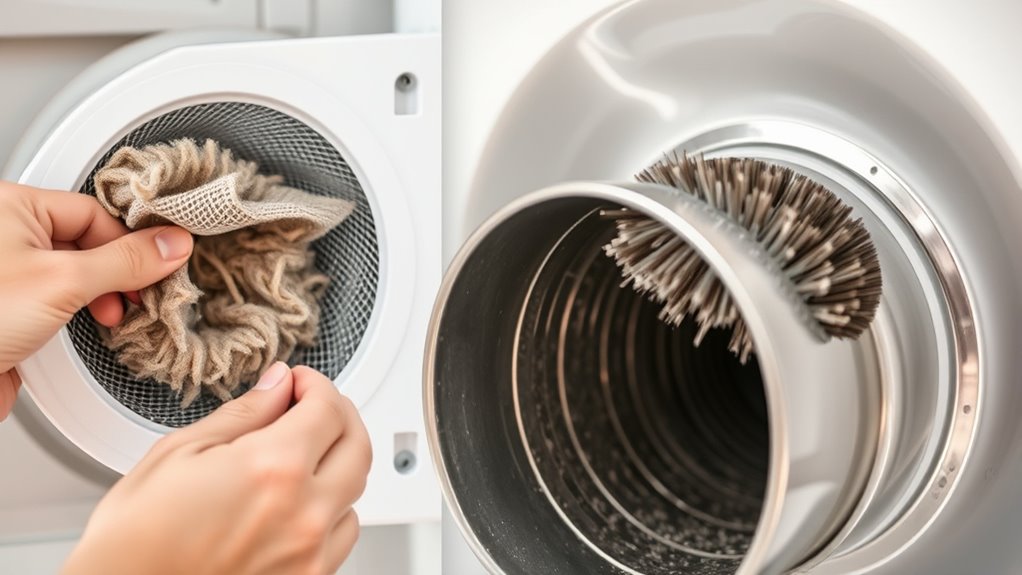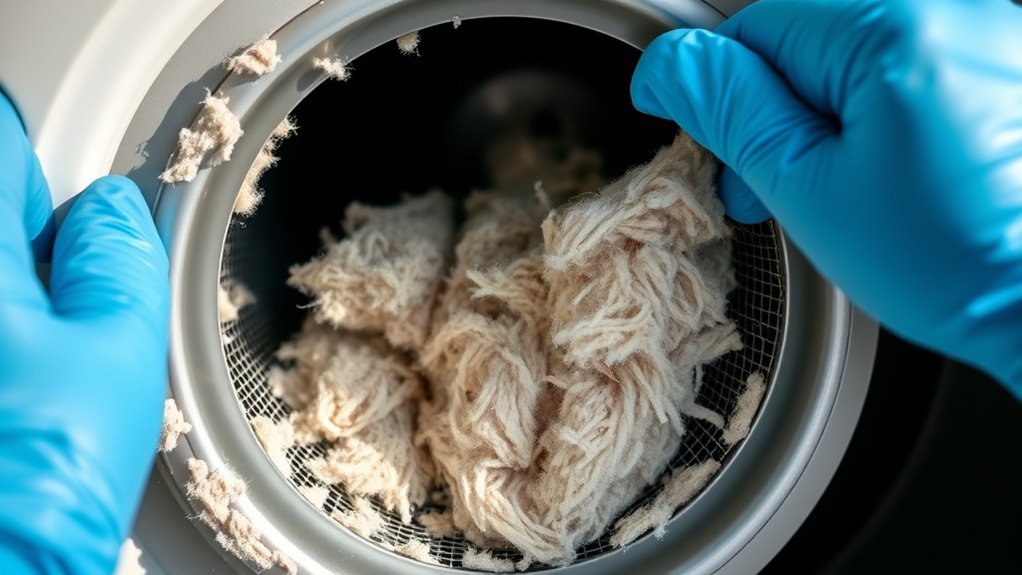To keep your dryer safe and efficient, regularly check and clean the lint trap after every load by removing lint debris and wiping it down. Inspect the exterior vent cover for blockages and clean out any lint inside the duct with a vacuum or vent brush. If you notice longer drying times or a burning smell, it’s time for a more thorough cleaning or professional help. Keep these tips in mind to prevent fires and extend your dryer’s life.
Key Takeaways
- Inspect and remove lint from the trap after every load to ensure proper airflow.
- Clean the lint trap thoroughly with water or a brush periodically to remove fine debris.
- Check the exterior vent cover regularly for lint buildup and debris, clearing as needed.
- Disconnect the vent duct and use a vent brush or vacuum to remove lint inside the duct.
- Schedule annual professional vent cleaning if you notice longer drying times or a burning smell.

Regularly checking and cleaning your dryer’s lint trap and vent is essential to keep your appliance running efficiently and safely. Over time, lint accumulation builds up not only in the trap but also deep within the vent system. If you ignore this buildup, it can lead to vent blockage, which hampers airflow and causes your dryer to work harder. This increased effort uses more energy, raises utility bills, and shortens the lifespan of your appliance. More importantly, a blocked vent significantly increases the risk of overheating and fire, making it crucial to stay vigilant about maintenance.
Regularly clean your dryer’s lint trap and vent to prevent fire hazards and improve efficiency.
Start by inspecting the lint trap after every load. Remove the trap and clear away all lint debris. Even if it looks clean, give it a quick wipe or rinse to remove any fine particles that might be missed. A clean lint trap ensures proper airflow and prevents lint from escaping into the vent system. Remember, lint is highly flammable, so the cleaner your trap remains, the safer your dryer is. Regular cleaning prevents lint from escaping into the vent, reducing the risk of vent blockage, which can trap heat and increase fire hazards.
Next, focus on the vent itself. Over time, lint can bypass the trap or accumulate further down the duct, especially if the trap isn’t cleaned regularly. Check the exterior vent cover periodically; if it’s clogged with lint or debris, clear it out. Use a vacuum cleaner with a hose attachment to remove lint inside the duct. For more thorough cleaning, disconnect the vent from the back of the dryer and use a vent brush to scrub away lint buildup inside the duct. This step is vital because even small amounts of lint can restrict airflow, causing your dryer to dry clothes unevenly or take longer than necessary. Incorporating dryer vent maintenance into your routine can greatly improve your dryer’s efficiency and safety.
Don’t forget to inspect for any signs of vent blockage, such as increased drying time or a burning smell during operation. If you notice these signs, it’s time to clean more thoroughly or call a professional. Regular maintenance of your dryer’s vent system not only improves efficiency but also minimizes fire risks. Make it a habit to clean the lint trap after each use and schedule a thorough vent inspection and cleaning at least once a year. Doing so can save you money, extend your dryer’s life, and most importantly, keep your home safe from potential fire hazards caused by lint buildup and vent blockage.
Frequently Asked Questions
How Often Should I Replace My Dryer Lint Trap?
You should replace your lint trap if it becomes damaged, cracked, or excessively worn, which can affect lint trap maintenance. Typically, you don’t need to replace it often; instead, clean it regularly to guarantee proper vent cleaning frequency and ideal dryer performance. Check the trap after each load, and replace it when cleaning no longer restores full function or if you notice damage. Proper maintenance keeps your dryer running efficiently and safely.
Can I Use a Vacuum to Clean Inside the Vent?
Yes, you can use a vacuum to clean inside the vent, but you need to prioritize vacuum safety. Use a brush attachment to carefully remove lint buildup, and avoid forcing the vacuum too deep to prevent damage. Before starting, perform a thorough vent inspection to identify blockages. Regular cleaning with a vacuum helps maintain airflow and reduces fire risk, keeping your dryer running efficiently and safely.
Are There Any Signs of a Blocked Dryer Vent?
If your dryer’s airflow feels sluggish or takes longer to dry clothes, it’s like a traffic jam blocking your path. These are signs of a blocked dryer vent, which causes airflow restriction and can turn into a fire hazard if left unchecked. You might notice overheating, a burning smell, or excessive lint around the vent. Regularly inspecting and cleaning your vent keeps your dryer running efficiently and keeps your home safe.
What Tools Are Best for Cleaning the Vent Thoroughly?
You should use vent cleaning tools like a long, flexible brush to thoroughly clean your dryer vent. Look for a brush with stiff bristles and a sturdy handle to reach deep into the vent. A vent brush kit often includes different sizes, so select one suited to your vent’s diameter. These tools help dislodge lint buildup and guarantee proper airflow, reducing fire risk and improving dryer efficiency.
How Does a Clogged Vent Affect Dryer Performance?
A clogged vent reduces your dryer’s efficiency because it traps heat and moisture, making the cycle longer and less effective. This buildup forces your dryer to work harder, increasing energy use and wear on components. More importantly, it creates a fire hazard as lint and heat accumulate, risking a dangerous fire. Regularly cleaning your vent helps maintain ideal dryer performance and keeps your home safer.
Conclusion
By regularly checking and cleaning your dryer’s lint traps and vents, you keep your laundry routine smooth and worry-free. Think of it as giving your appliance a gentle gust of fresh air, allowing it to work more efficiently. With each maintenance, you’re nurturing a safer, more inviting home — where your clothes come out fresh and your space stays cozy. A little attention now keeps everything running effortlessly, turning chores into a breeze.










